Euphorbia milii
I have more than one buddy who is offbeat, charming, and cheerful – but prickly and off-putting every now and then.
One of my favorite houseplant friends, the crown of thorns (Euphorbia milii) has that same personality.
It’s a bit odd looking, with the inch-long, sharp spines covering the otherwise bare stems, and just a few leaves on the tips of the branches.
Along with its offbeat appearance, E. milii has beautiful blooms and is one of the few houseplants that can flower most of the year without much maintenance.
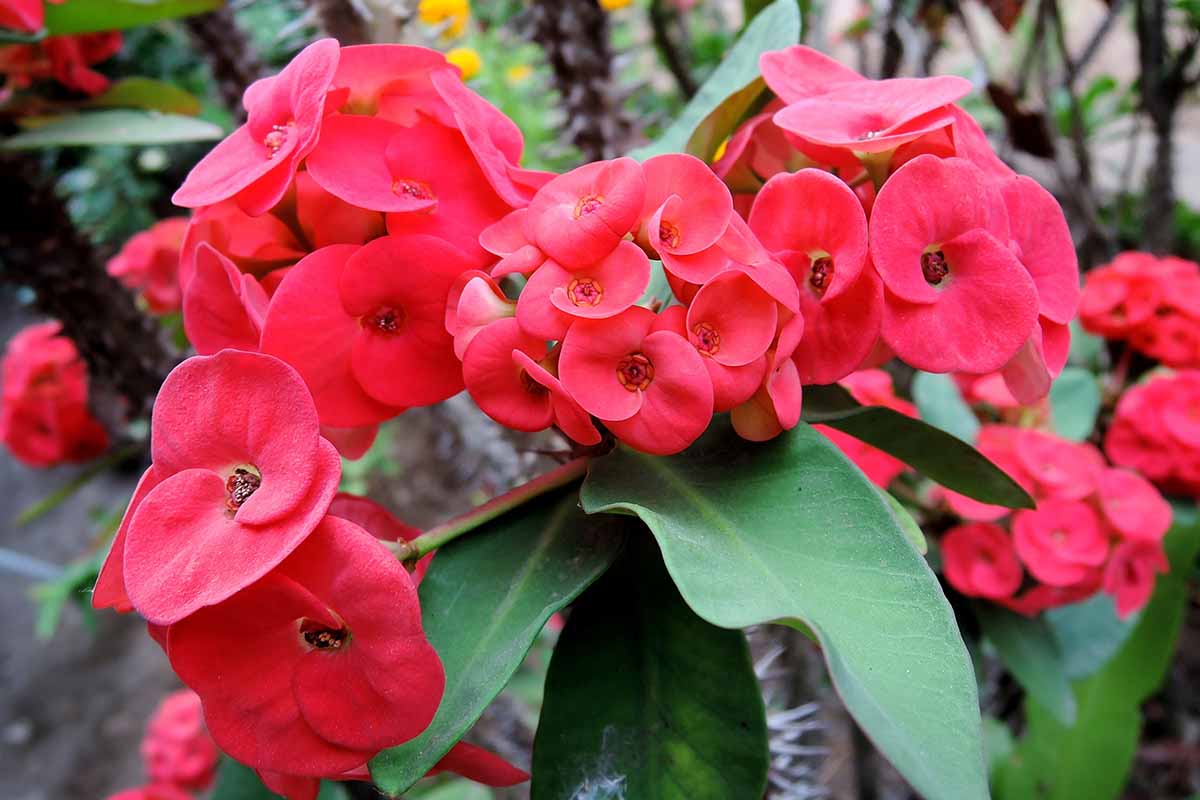
We link to vendors to help you find relevant products. If you buy from one of our links, we may earn a commission.
The showy, day-brightening “flowers” are composed of small florets held in colorful bracts that look like rounded flower petals of pink, red, white, yellow, or variegated combinations.
A few varieties sport more greenery, but most types of E. milii look like cacti or barbed wire with sparse green leaves at the stem tips.
Scratchy spines notwithstanding, this plant is not a cactus, but a hardy succulent – easy to propagate and undemanding in its growing requirements.
Sounds fun, right? But there are a few sticking points with this blooming indoor plant.
Literally! The spines can give you a sharp jab, so you’ll want to wear thick garden gloves when you repot, move, or prune these plants.
Unlike many pet- and kid-friendly succulents, crown of thorns is also toxic. The stems contain a milky latex that can cause vomiting – or worse – if ingested. The sap may cause contact dermatitis too.
But if you can cope with those less-delightful traits, E. milii could be the houseplant for you.
Let’s get to know this prickly-but-adorable plant a bit better. Here’s what’s in store:
What You’ll Learn
What Is Crown of Thorns?
Part of the spurge, or Euphorbiaceae family, Euphorbia is a genus of about 2,000 known species, many of them with wildly disparate looks.
This diverse genus includes species of 20-foot trees, four-inch herbaceous plants, poinsettias, as well as the gopher plant.
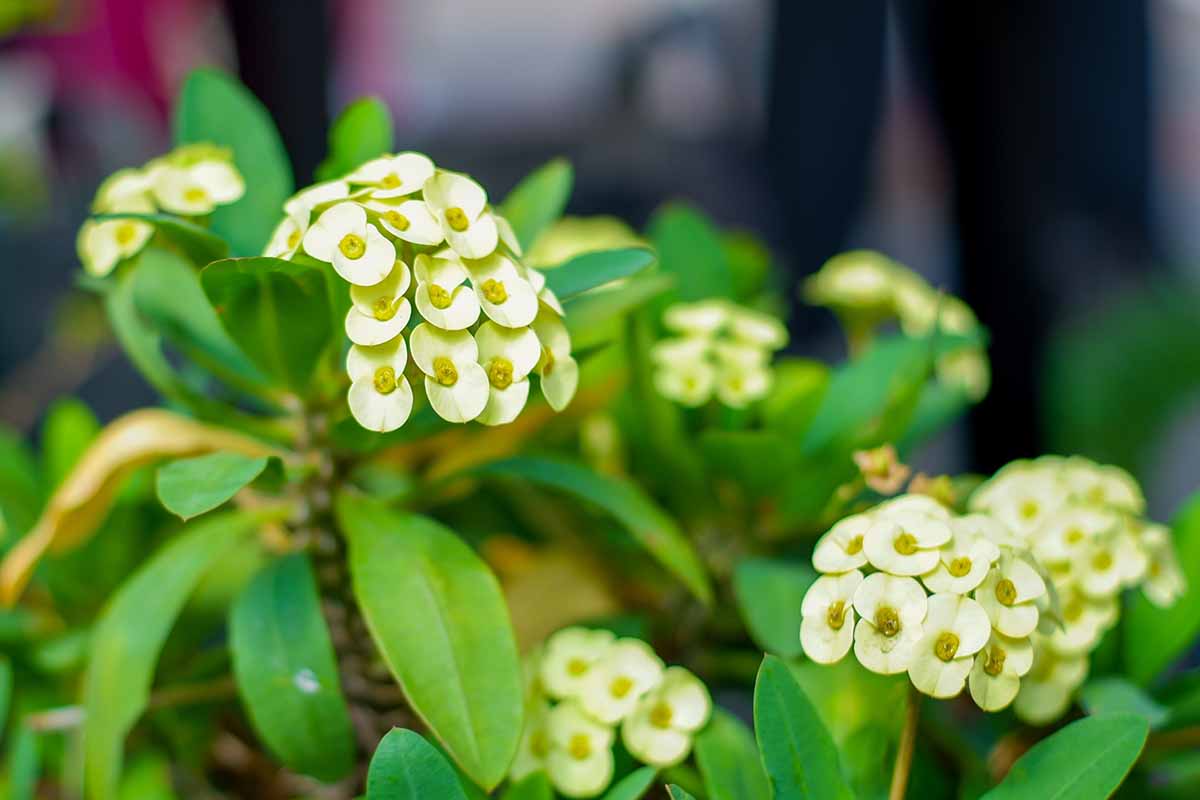
The common name comes from a legend of the plant being used to make the crown of thorns for Jesus’ crucifixion.
While botanists and Biblical scholars have found evidence that this plant was likely present in the Middle East before the time of Christ, the general consensus is other plants were more likely to have been used, and not E. milii.
This succulent is known by the alternate names of Christ thorn and Christ plant, however.
This species shares traits with other types of euphorbia, including a need for full sun and the presence of the toxic milky sap mentioned above.
E. milii has distinct traits such as the sharp thorns on the stems and ability to flower prolifically over a long period.
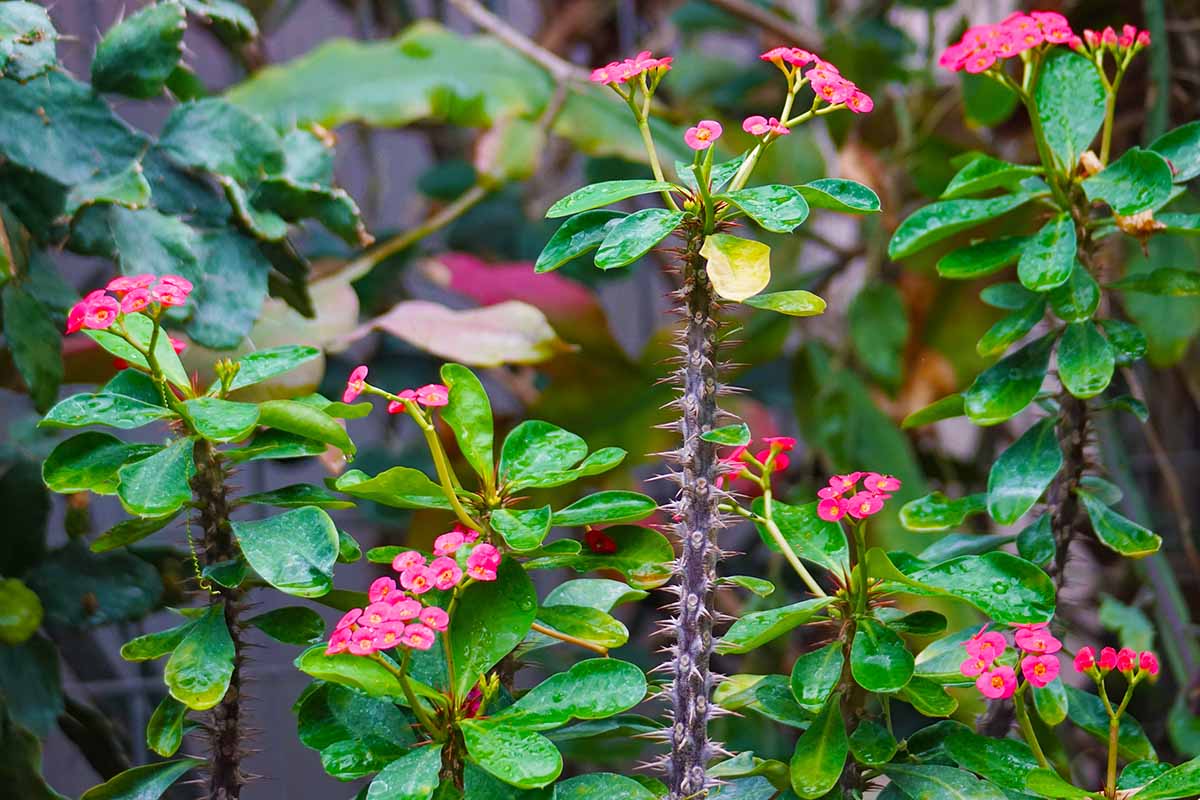
The blooms are showy, consisting of insignificant greenish, yellow, or red flowers surrounded by colorful, sometimes variegated, floral bracts.
In USDA Hardiness Zones 9 to 11, crown of thorns will grow as perennials and bloom year-round. Grown as a houseplant, the plants typically bloom from late winter fall.
It has a shrublike, multi-stemmed growth habit and reaches three to six feet tall outdoors, but generally tops out at two feet tall indoors.
The stems are thorny, with terminal green or variegated succulent leaves that fall off after a few months, with spines growing in their place.
It’s technically a succulent or semi-succulent, but needs more direct sun than most succulents and more water than cacti.
The species E. milii is native to Madagascar and has naturalized in areas of Asia and South America.
Its botanical name milii honors the governor of Bourbon island, now called Reunion, Baron Milius, who first cultivated this species in 1821.
Many crown of thorns hybrids and cultivars were introduced more recently, starting in the1970s. Some boasted improvements such as more compact forms, an ability to bloom in containers just a couple of inches wide, and resistance to drought and overwatering.
The original hybrids were generally crosses of E. milii and E. lophogano, a similar species with long, leathery green leaves.
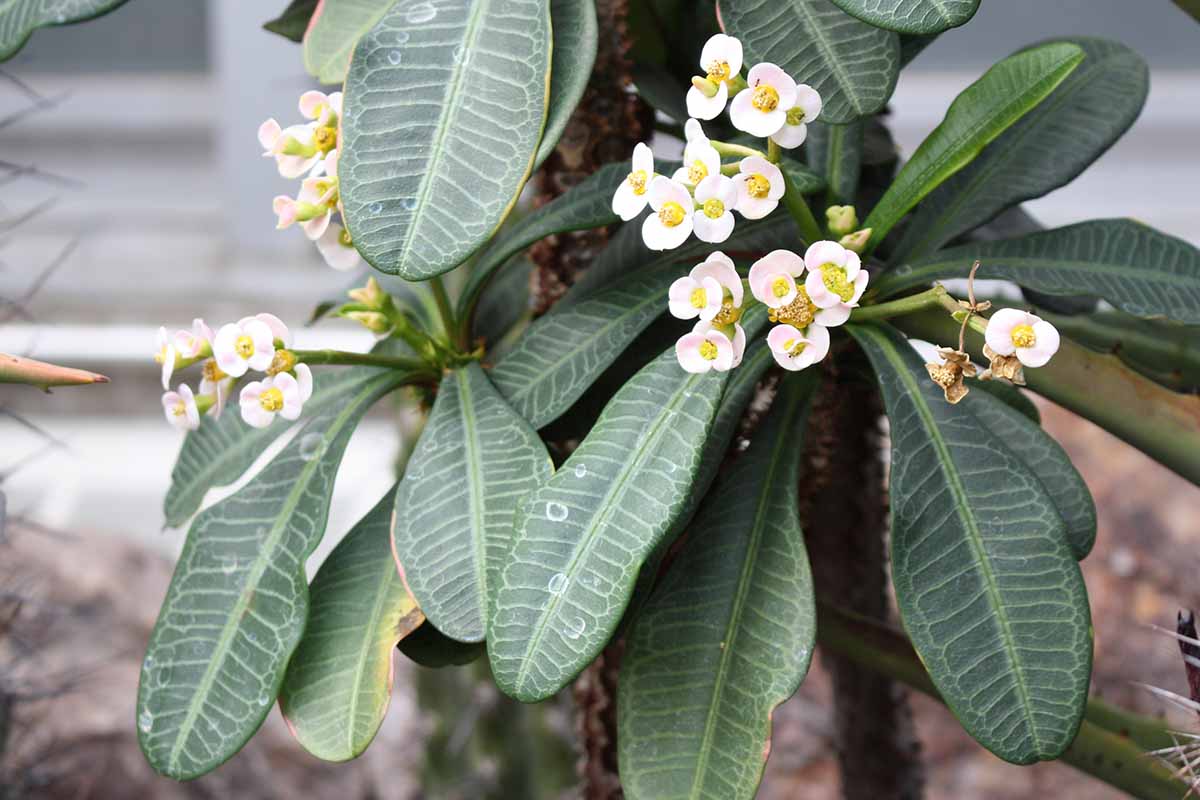
The crosses include stout-stemmed “giant” crown of thorns hybrids with lavish blooms bred in California.
German horticulturalists crossed natural selections to breed hybrids with thicker leaves and more slender stems than the California giants, and dwarf cultivars followed.
In the early 1990s, horticulturists introduced large-flowered “Poysean” cultivars that had come to Thailand with Chinese immigrants.
The first new varieties were most likely the result of mutations, not hybridization. Their shared traits included large, bright green leaves, and an upright, rounded-top growing habit.
Further selective breeding in Thailand produced showy bloomers in an exhaustive range of colors and sizes.
The beautiful blooming succulents proved to be quite popular, and Thailand’s economic boom at the time financed the development and purchase of hundreds of unusual, rare, collectible varieties.
Sadly, when Southeast Asia’s economic prosperity was followed by a crash in the late 90s, the growers and buyers suffered financial losses.
The market dried up, and many Thai cultivars were lost as breeders went out of business.
Some growers still offer the Poysean varieties, but the rarer types aren’t usually available to collectors in US or European markets.
One example of a Thai variety still available is ‘Queen Millionaire,’ a hybrid which grows about two feet tall as a houseplant and produces pink bracts with cream-colored edges. The blooms can reach two inches across.
Another Thai giant, ‘Cherry Cobbler’ aka ‘Red Beauty,’ and has two-inch bright red bracts that resemble hydrangeas.
In a bit, I’ll share buying information for different types of crown of thorns, Meantime, let’s have a look at their growing requirements.
Crown of Thorns Propagation
It is possible to propagate crown of thorns from seed, but unless they are growing outdoors the plants need to be hand-pollinated to yield seeds – and the seeds must be sown just as soon as they ripen.
Even if you already have thriving plants, they may not bloom reliably or precisely when you’re ready to sow.
Additionally, seeds collected from hybrids may not grow true to the parent plant and in some cases may not be viable.
I would leave growing from seeds produced by hand-pollinated flowers to amateur plant breeders and horticulturists.
For the more casual grower, I recommend purchasing plants or rooting stem cuttings.
From Cuttings
To propagate crown of thorns from stem cuttings, first don protective gloves and wear long sleeves to protect your skin from the spines and sap.
Also, put newspaper or a machine-washable towel on the work surface, or work outside where no one will end up with sap on their hands or paws when you’re finished working.
Clip a terminal end of a healthy stem using a knife and dip it in cold water to keep the sap from spurting (or should I say spurging?) everywhere.
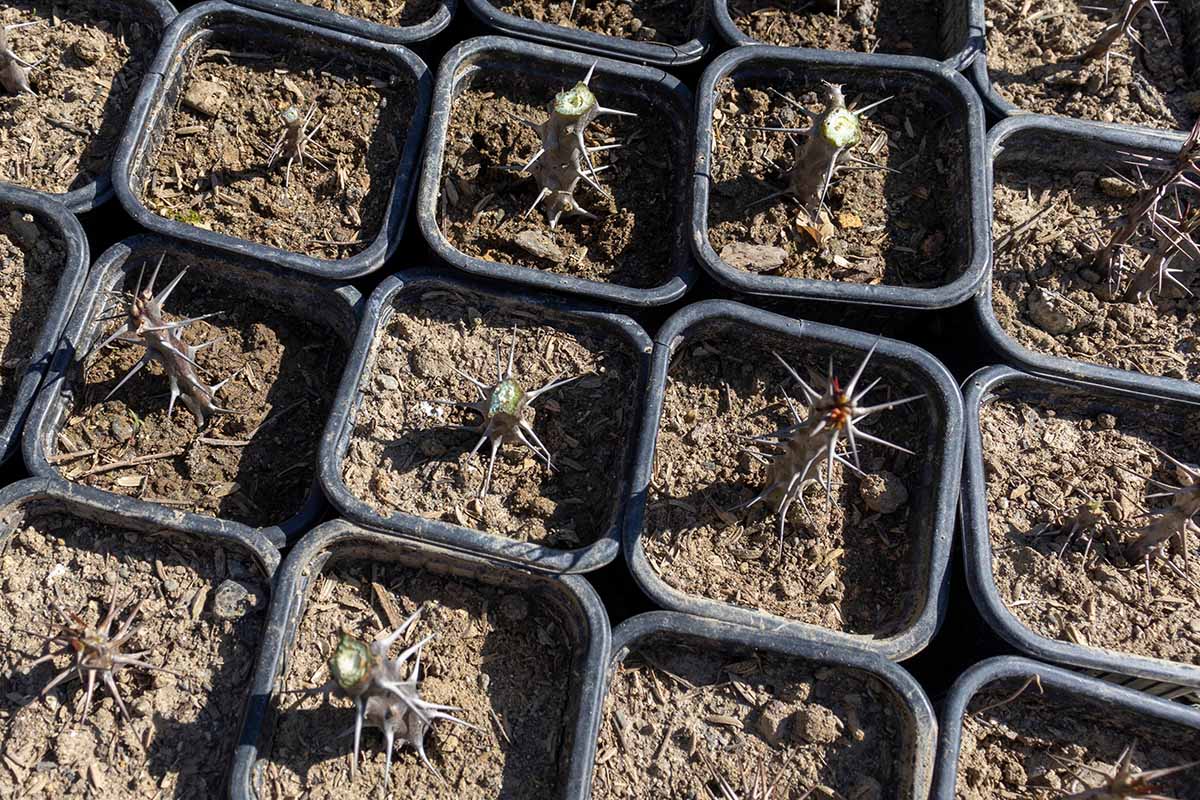
If you’re making the effort and have a large enough parent plant or plants, I’d recommend that you try to propagate five or six cuttings at once to increase your odds of success.
Set the cuttings in a warm, dry place away from direct sunlight. I usually rest mine on parchment paper on a bookshelf the cats can’t reach.
Let each cutting dry until a callous forms on the cut end, which usually takes a few days. Then, gently poke the calloused end into a tray or cell of well-draining potting or seed-starting mix.
After planting, keep the soil barely moist and place the container in a warm, well-lit area. Within about two months, you should be able to detect roots with a gentle tug, but be sure to wear gloves to protect your fingers.
You can find complete instructions on starting crown of thorns from seed or cuttings in our guide to growing euphorbia.
Transplanting
Whether you’re rehoming a rooted cutting or potting a purchased houseplant, you’ll need the right soil.
Crown of thorns prefers a mildly acidic to neutral pH, with 6.0 to 7.0 being the ideal. They can also cope with slightly alkaline soil, with a pH between 7.0 and 7.5.
Happily, houseplant potting mix pH is ordinarily 7.0 out of the package, so you won’t have to worry much about balancing pH like you would if growing these succulents in garden soil.
Do pay close attention to acquiring or creating a well-draining potting mix high in organic matter, however.
Crown of thorns will languish if its soil holds too much water or can’t retain nutrients.
Most potting mixes formulated for cacti and succulents offer the proper balance of drainage and richness but look for one that doesn’t contain added fertilizer.
I’ve gotten good results with Harris Succulent and Cactus Mix, which includes ingredients such as perlite, forest humus, and fishbone meal.
Harris Succulent and Cactus Mix
It’s available in four-quart bags via Walmart.
You can also make a mix of high-quality, all-purpose potting mix and perlite in a two-to-one ratio.
If you have potting soil but need the perlite, you can find an eight-quart bag of Miracle-Gro Perlite available from Walmart.
The best containers for crown of thorns houseplants are made from a porous or lightweight material and have drainage holes at the bottom.
The pot should be just an inch wider than the spread of the plant. Crown of thorns prefers to be snug in its pot, and too much space increases the risk of waterlogged soil.
It’s also essential to place a saucer below the pot to catch excess water for disposal. The saucer should hold water but it need not be porous or coordinate with the pot.
You can go with a spare saucer or dinner plate if you’re on a budget or like to repurpose.
If you’re purchasing a new pot, August Grove Purnell Planters make a good choice for modest-size crowns of thorns.
Made from unglazed terra cotta, they are cylindrical with straight sides and have drainage holes and a detachable saucer with a lip to hold overflow water.
A set of two four-inch wide planters with saucers is available from Wayfair.
You can learn more about selecting the best houseplant pots and the proper growing mix in our guide.
Once you’ve obtained the plant, potting mix, and container, transplanting is pretty quick.
Gently ease the plant from its container, being careful not to break stems or hurt yourself in the process.
Fill the pot about two-thirds full with the mix, and then center the root ball on the soil so it rests at the same level it was in the previous container.
Backfill with potting mix, tamping it firmly around the roots, using gloves or perhaps a pot holder to protect your hands – or pressing down with the back of a metal or wooden spoon.
Water it in and give it ample opportunity to drain before placing the pot in the hospitable location you’ve already selected.
Then it’s time to tend your crown of thorns and enjoy its offbeat appearance and showy blooms.
Tips for the growing process are coming up.
How to Grow Crown of Thorns
Like that friend who is only prickly and oversensitive occasionally, a crown of thorns houseplant has a few non-negotiable growing requirements but is carefree the rest of the time.
Where you locate an indoor E. milii is especially important.
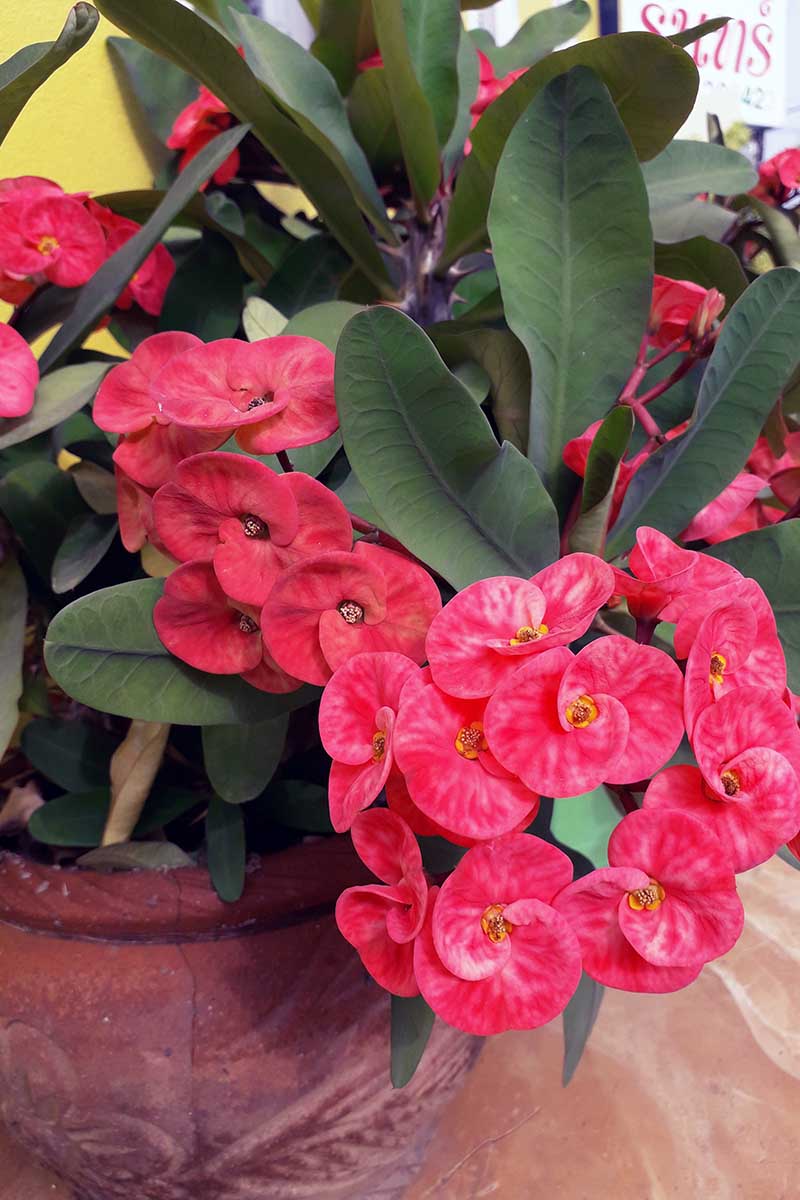
There aren’t many houseplants with this trait, but even indoors, the crown of thorns responds best to at least six hours of direct sunlight per day!
Be sure to place it on a sunny windowsill or a few feet away from a south-facing window. If your chosen location only receives morning sun, you’ll need to augment it with grow lights.
The plants also prefer low humidity of 40 percent or less, though they’re usually okay in moderate humidity, up to about 50 percent.
I consider the humidity preference a selling point since only the rare blooming houseplant flowers inside a home with dry air.
Temperature is also key. While some of the newer cultivars may be cold-tolerant, the typical crown of thorns does best when indoor temperatures are in the 65 to 75ºF range.

When daytime temperatures are cooler than about 60ºF, the plants will struggle to bloom or produce new leaves.
If you keep your home cooler at night, they’ll do fine with nighttime temps in the 50 to 60ºF range.
But once the air cools to below 50ºF, premature leaf loss can occur. And even a single freeze can kill a crown of thorns outright, so be sure to look out for them if you have a power outage in wintery weather.
You’ll also want to place your crown of thorns where it won’t encounter drafts.
Be sure to water the plants only when the soil is dry at least four inches down.
Then pour water into the container at the soil surface until you see it draining from the holes into the saucer below. Discard any excess promptly since oversaturated soil can kill crown of thorns.
Once your indoor plant stops flowering, usually between fall and late winter, you can water even less frequently. In those seasons, allow the soil to dry completely before thoroughly dousing your succulent and letting it drain out of the bottom of the pot.
The fall and winter watering schedule usually works out to just once a month or so, but let your soil moisture meter or your forefinger plunged into the potting mix be your guide.
My favorite method with euphorbia varieties is to bottom water, and you can learn more about that in our guide.
You don’t need to feed crown of thorns succulents. But they will grow fuller and be more likely to flower abundantly when you apply fertilizer once a month during the spring and summer.
Dilute water-soluble fertilizer to half the recommended strength to promote increased flowering over foliage.
One good option is is this liquid product, formulated for poinsettias and other euphorbia species. It has an NPK ratio of 2-4-6 and needs to be diluted before application.

Water-soluble Poinsettia Feed is available in 8.4-ounce bottles of concentrate from GREEN24 via Amazon.
Stop adding fertilizer a full month ahead of fall in your area. Shorter days signal the plant to slow down active growth, even for houseplants, and excess fertilizer in fall and winter can burn roots and cause leaves to turn brown.
Growing Tips
- Expose the plants to six to eight hours of direct sun, a grow light, or bright, indirect light daily.
- Plant in a well-draining potting mix.
- Place containers away from drafty or windy spots.
Pruning and Maintenance
You won’t need much to keep a crown of thorns happy, but upkeep can be a literal pain if you’re not careful to avoid the thorns and sap.
Leather garden gloves can help you avoid pricks and punctures. Rugged Guard Leather Gloves are a good option.
They feature protective leather palms, recycled moisture-wicking flower-pattern material on the backs, and fingertips that allow you to work with touch screens.
You can find Rugged Guard gloves in four unisex sizes from small to XL at Farmer’s Defense.
Keep those gloves ready for maintenance tasks, like regularly disposing of dead leaves or spent blooms that have fallen on the surface of the growing mix.
The debris can easily rot when wet, contributing to oversaturated soil and the risk of disease.
You may also wish to prune your crown of thorns houseplant, either to keep it compact, to shape it, or to remove damaged or diseased tips or leaves.
Even E. milii grown year-round indoors do best if you wait until spring or summer to trim.That’s when the plant is putting on new growth and will be able to heal from its wounds and send out new shoots.
Don gloves before grappling with the crown of thorns, and use a knife or dishwasher-safe shears so you can wash the blades easily.
The first order of business is to get rid of any damaged branches, cutting them away at the soil level and gingerly disposing of them. The stems are not good candidates for the compost.
Use a spray bottle of icy water to spritz the cuts you make as this will halt the flow of the sap.
If you’re shaping the plant, decide where you’d like it to branch out. Ordinarily, a pruned stem or branch will send out two or three new growths from the spot where you cut.

You can clip the stems about a third down or lower. But avoid cutting so much of the stem that you lop off healthy buds since they’re the source of new growth.
To give the houseplant every chance to resprout and flower, remove no more than half of the leaves, preferably no more than a third at any given time.
If you are pruning in spring, you can root those cuttings readily, so give it a try!
You may opt to move the plants outdoors in the warmer spring and summer months.
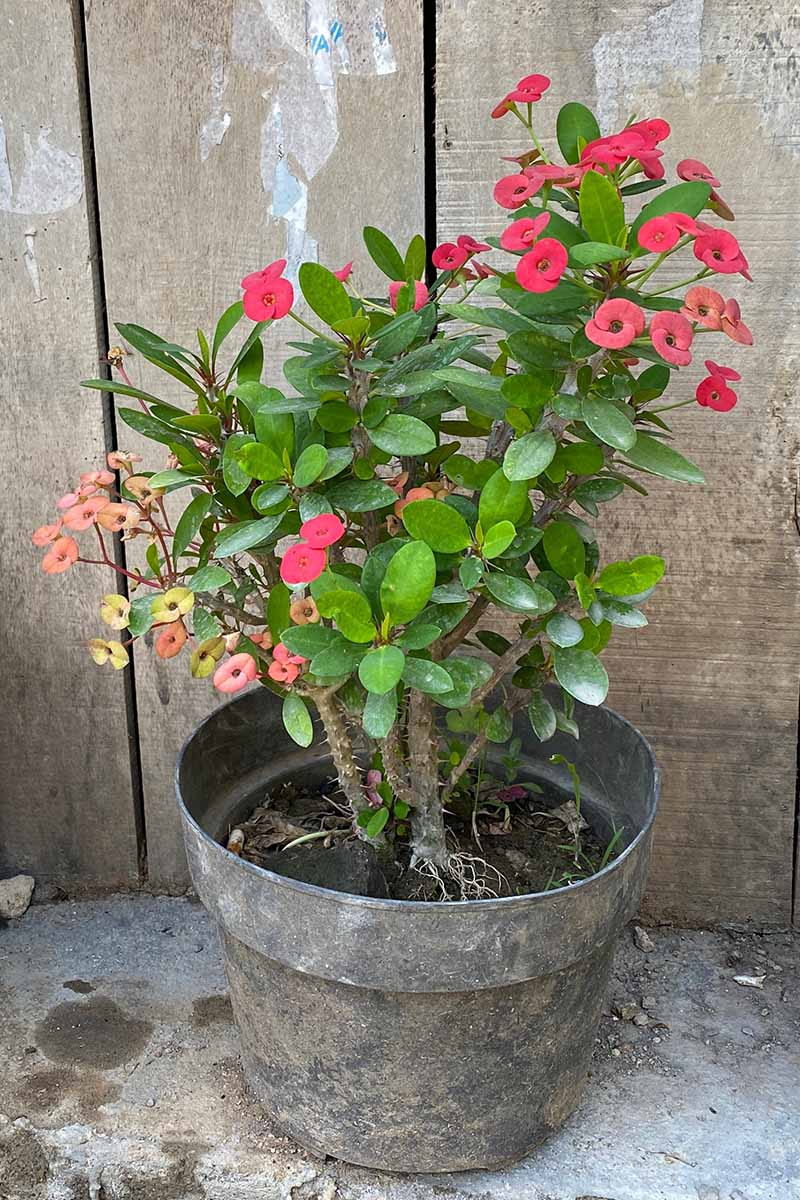
This approach may cause a growth spurt, and it will usually cut down on your watering chores, not to mention the need for supplemental light.
When temperatures are reliably above 60°F, shift the containers outdoors to a spot that receives plenty of direct sun but is protected from drafts, wind, and harsh afternoon rays.
To keep the leaves from getting sunburned, give the plants a chance to adjust to increased light and different temperatures outdoors. Expose them to increasing hours in the outdoors over the course of a few days or a week.
If your summers are scalding hot, place the pots where they’ll receive only part sun, or use shade cloth to protect them from the strong afternoon rays.
Also consider bringing them inside when temperatures exceed 80°F, which can cause the plant to become too dry or drop all of its foliage.
Consistently clear any debris that settles on the surface of the potting mix, ideally before rain makes it soggy.
When the containers are outside, consider the rainfall, which usually provides all the hydration the plants need but may also overwhelm them.
Provide each outdoor container with a drainage saucer and always tip out any excess after a downpour. And only offer supplemental water if the soil is dry four inches down.
You may also want to fertilize the plants while they’re in prime growing mode outdoors, using the same water-soluble all-purpose fertilizer mentioned above. Dilute it to about half the manufacturer’s recommendation.
Keep an eye on the temperature as summer starts winding down. Mark a date on your gardening calendar about two months ahead of your area’s average first frost date, and start watching the weather then.
While certain modern hybrids of E. milii may survive temperatures as low as 35°F, it’s best not to take chances. Move your crown of thorns indoors when temperatures are predicted to be below 60ºF – or 55ºF at the lowest.
Inspect plants for infestations of mealybugs or other pests before bringing them indoors. It’s far simpler to treat those maladies outdoors before they infest your entire houseplant collection.
Crown of thorns will eventually need a new pot, too. A snug fit increases the number of blooms, so don’t rush to give them a new home.
Usually, once every two years is fine, or even less often if you’re trying to limit the size of your houseplant. If the roots are escaping from the drainage holes or the soil is so compacted the plant can’t take up water, go ahead and repot immediately.
Upgrade to a container just one inch wider than the current vessel. Be sure to replace the growing medium with a fresh batch of potting mix that’s well-draining and contains plenty of aged organic matter.
Once the houseplants are full-size, usually about two feet tall unless you’re growing a bigger hybrid, adding a bit of fresh potting mix to the surface once a year can replace repotting.
After three years of adding soil at the top, change the whole mix out for some fresh, while retaining the same size container.
Isn’t it nice that these prickly plants need so little maintenance? That gives you less chance of a thorn in your finger and plenty of opportunities to admire their quirky growth habit and pretty blooms.
Crown of Thorns Cultivars to Select
If you’re enthusiastic about any and all E. milii plants, you’ll be able to find a fine plant to grow quickly, though it probably won’t be a specific cultivar.
An unnamed specimen with deep pink blooms is available in a four-inch pot from Hirt’s House Plants via Amazon, for example, and it’s a beauty.

If you can’t decide on a single color of blooms, some collections contain different colors without specific cultivar names.
For example, a three-pack with one each of either pink, white, red, or yellow blooms is available in two-and-a-half-inch containers from JM Bamboo via Amazon.

If you’re planning to grow your plants outdoors or want to get into the hobby of starting new specimens from cuttings, I’d recommend purchasing larger plants if they don’t cost substantially more than smaller ones.
Crown of thorns is relatively slow-growing, so you’ll have branches to behead and root more quickly if you start with a taller, more mature plant.
You can find two-packs of plants with red blooms available in two-and-a-half-quart containers from Vigoro via Home Depot.
You may also want to purchase one or more of the named cultivars or rare varieties, some with delightful pastel bracts, or variegated or pale leaves, and others with more ordinary blooms or leaves but special traits, like a compact size.
Here are a few more unusual options to consider:
Eos
Besides its compact growth habit, reaching just 12 to 15 inches tall at maturity, the main draw of ‘Eos’ is its colorful blooms.
The deep salmon-colored bracts have yellow tips and surround dark yellow centers. The lance-shaped succulent leaves are green with dark yellow midribs.
Pink Cadillac
‘Pink Cadillac’ will grow one or two feet tall, with multiple woody stems, leathery, dark green leaves, and signature bubblegum pink bracts surrounding yellowish florets.
It has barbs, but the blooms in Barbie’s favorite color more than make up for it.
‘Pink Cadillac’ is available in a two-and-a-half-inch pot from Hirt’s Gardens via Walmart.
Zephyr
Its bright green foliage and variegated bracts give ‘Zephyr’ an extra zip among E. milii cultivars.
The florets are an unusual color – striking red, not the green or gold typical of crown of thorns.
Bell-shaped, cream-splashed apricot “petals” are rounded and grow upright from the stem tips, giving the overall effect of candies or perhaps floral smiles.
It’s amazing to think they will bloom like that inside for almost nine months of the year. Talk about a day brightener!

The leaves fall within a month or so of unfurling and are replaced with more spines as the plant grows to its full indoor height of one to two feet.
‘Zephyr’ is available fully rooted in an unpotted soil pod from The Green Escape via Amazon.
Managing Pests and Disease
Crown of thorns are known as easy-care plants, and their resistance to pests and diseases aids the cause, particularly in the case of newer hybrids.
To be on the safe side, it’s still a good idea to familiarize yourself with these pests and diseases that could strike:
Pests
Grown inside, E. milii usually avoid infestation. The plants might experience the occasional mealybug or scale attack, especially if you set them outdoors in the summer and then move them indoors for the cold months.
Spider mites and thrips may also make a move.
But don’t worry too much. You can typically take care of any pest problems with a sharp spray of water from the hose or perhaps an application of neem oil.
Disease
Crown of thorns is stubbornly sturdy and almost impervious to disease as long as you grow it in a well-draining potting mix and ample light, and don’t overwater.
If your plant isn’t receiving enough light or is being overwatered, it may suffer from powdery mildew, which is caused by Podosphaera euphorbiae and manifests as a floury coating on the leaves.
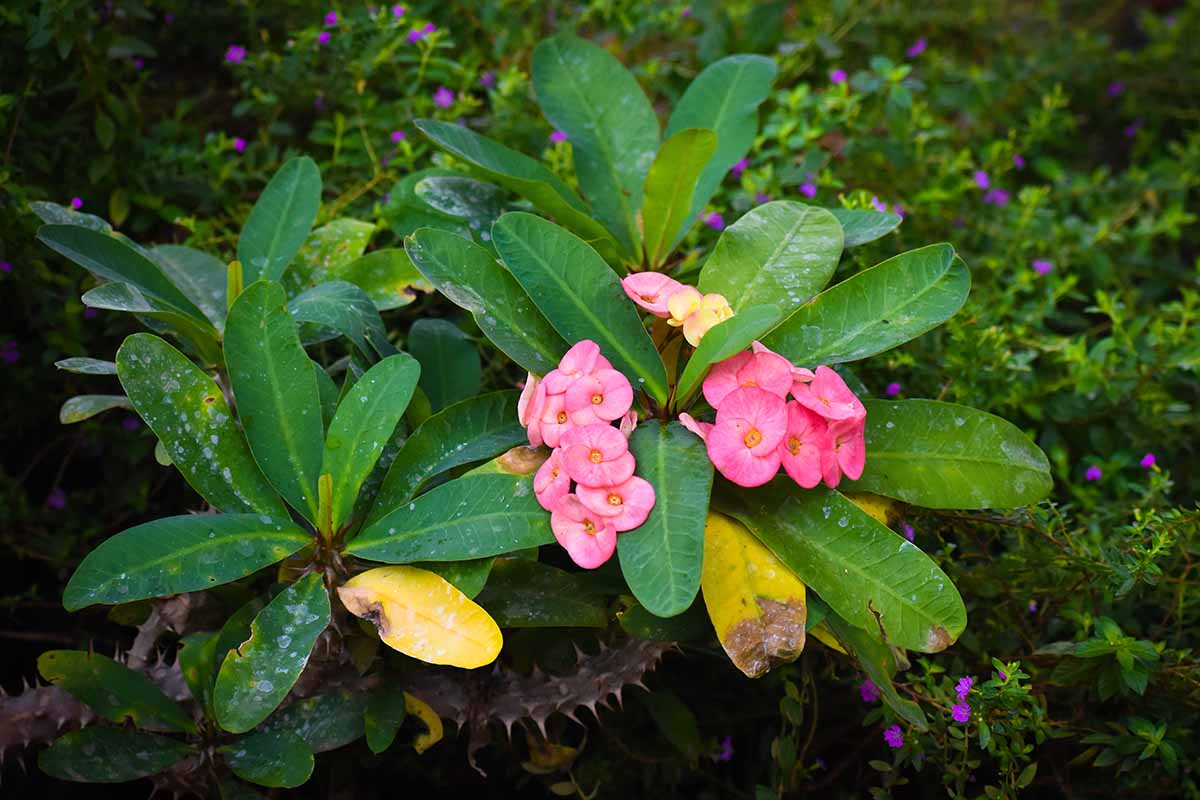
Powdery mildew is more likely if you take your houseplants outdoors for the summer where they can catch all those wonderful rays, but you can’t control the rainfall.
Reduce the risk by tipping excess water out of the drainage saucers after a drenching.
If you do spot the white dust that indicates powdery mildew, you can usually treat it with a spray of milk or one of the other natural remedies in our guide.
Also, be wary of root rot. Caused by waterborne fungi and water molds such as Pythium spp., root rot will make it impossible for a crown of thorns to take up water.
The first clear indication of this disease is wilting or yellowing leaves, but by the time you notice them the roots are already rotted and foul-smelling.
At that point, your only option is to dispose of the infected plant and all the debris and potting mix and start over with a new pot and plant – and fresh potting mix.
It’s far easier to prevent root rot than to endure the loss of a plant.
Provide drainage holes, well-draining potting soil formulated for succulents and cacti, and a porous pot that will dry readily, such as one made of unglazed terra cotta.
Never use a pot more than an inch or two wider than the plant. Extra soil mix on the sides can trap water and create a bog. Err on the dry side when watering.
The plants need saturating, but only when the soil is nearly dry. It’s just as important to let excess water drain out and discard it.
You can learn more about root rot in our guide.
Best Uses for Crown of Thorns
If you’ve been looking for a houseplant to brighten a sunny window without suffering damage from too much exposure, the crown of thorns euphorbia is a brilliant choice.
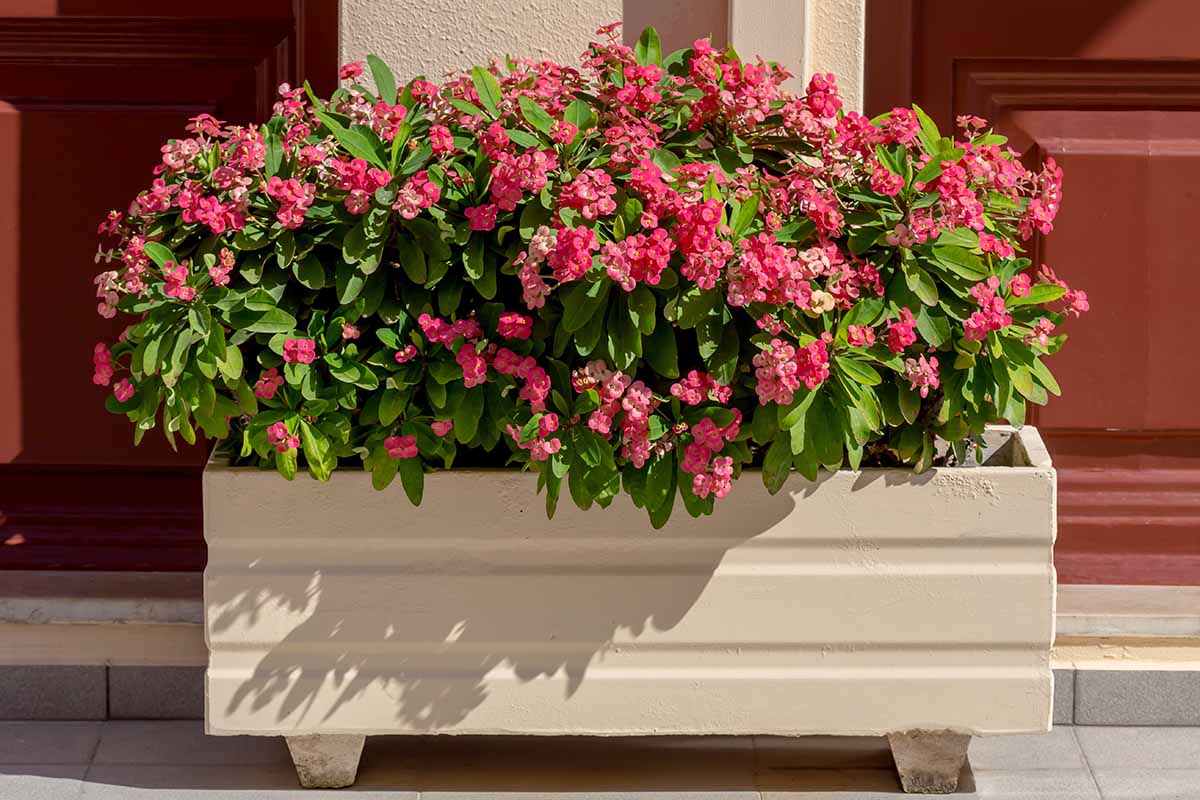
Not only will it thrive in direct indoor sun, but it will bloom there from late winter to early fall.
These easy-to-grow houseplants complement other potted succulents, especially those with lighter or fuzzy leaves, though they may need more sun than their fellows.
And they’ll thrive in low humidity, which is a boon for home gardeners who live in homes with dry heat in winter.
Quick Reference Growing Guide
| Plant Type: | Evergreen herbaceous shrub | Flower/Foliage Color: | Bicolored, burgundy, gold, pink, red, yellow, white / green, variegated |
| Native to: | Madagascar | Tolerance: | Drought |
| Hardiness (USDA Zone): | 9-11 | Maintenance: | Moderate |
| Bloom Time: | Late winter to fall (indoors) | Soil Type: | Potting mix formulated for cacti and succulents |
| Exposure: | Bright light | Soil pH: | 6.0-7.5 |
| Planting Depth: | Soil surface (seeds), rootball even with soil surface (transplants) | Soil Drainage: | Well-draining |
| Height: | 3-6 feet (outdoors) 2 feet (indoors) | Uses: | Bright light interior decor, houseplant for homes with low humidity, indoor or outdoor container gardens, winter blooming houseplant, security around home foundation, xeriscaping |
| Spread: | 1-3 feet | Order: | Malpighiales |
| Growth Rate: | Slow | Family: | Euphorbiaceae |
| Water Needs: | Low | Genus: | Euphorbia |
| Common Pests and Disease: | Mealybugs, scale, spider mites, thrips; Botrytis, leaf spot, powdery mildew, root rot, stem rot | Species: | Milii |
A Pretty Prickly Succulent Bloomer
Like friends I value who can be charming but sometimes prickly, I treat crown of thorns with a little extra sensitivity.
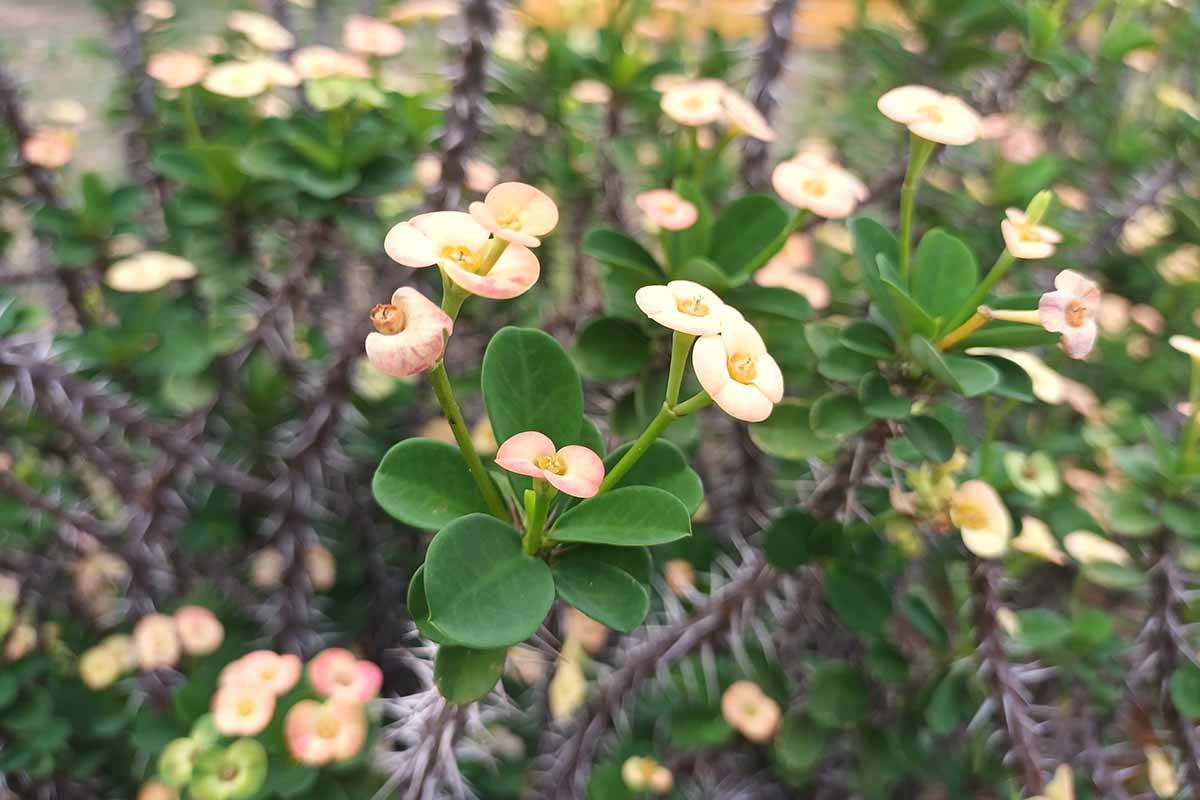
It’s worth donning gloves to repot, providing a grow light when sunlight is scarce, and keeping the houseplant out of the cat’s reach to enjoy these long-lived blooming succulents for years to come.
Do you think the crown of thorns is a worthy addition to your houseplant collection? We’d love to learn about your experience or field questions in the comments section below!
If this guide suited you, you can pick up more tips for choosing and growing blooming succulent houseplants in these guides:
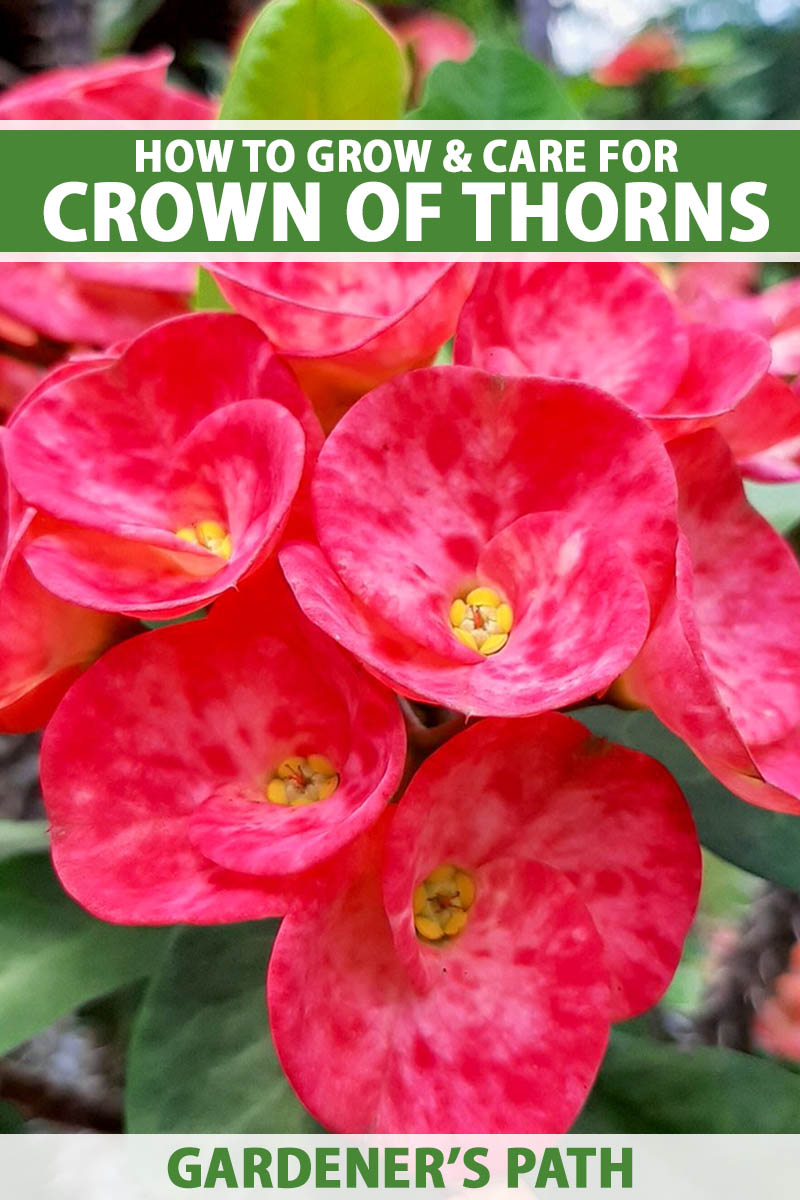




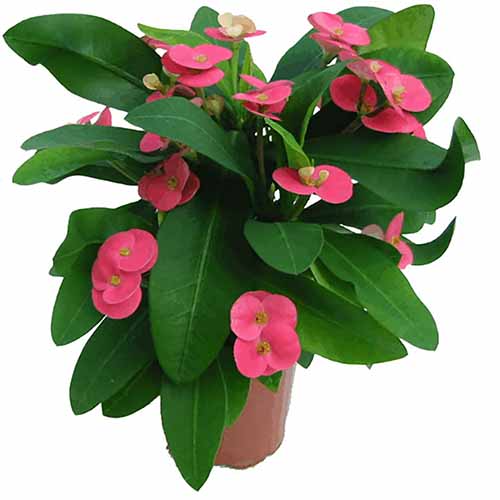
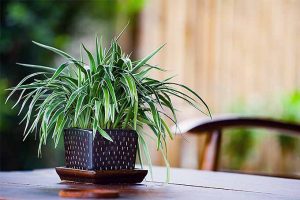
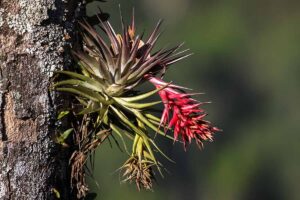
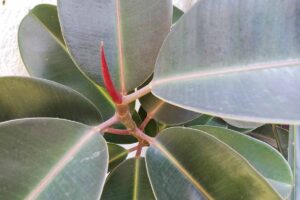
Thank you for your thorough and detailed article on this really special plant! It will help me care for one I picked up from people moving out of the country. I have definitely been watering it too much. It blooms all year long inside — do I assume it doesn’t have seasons?